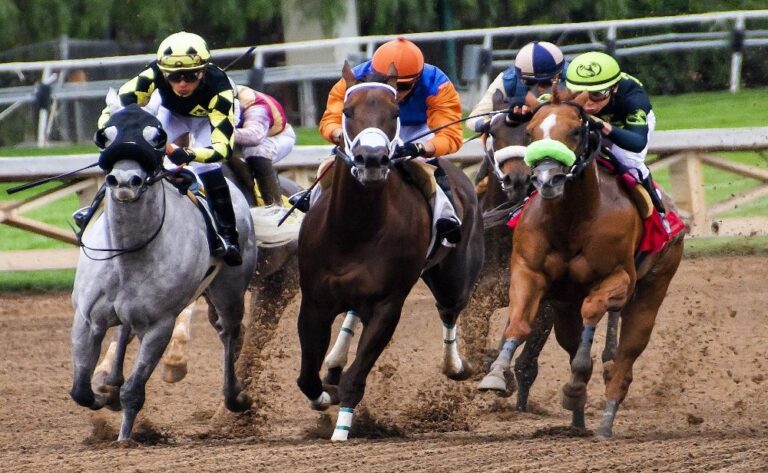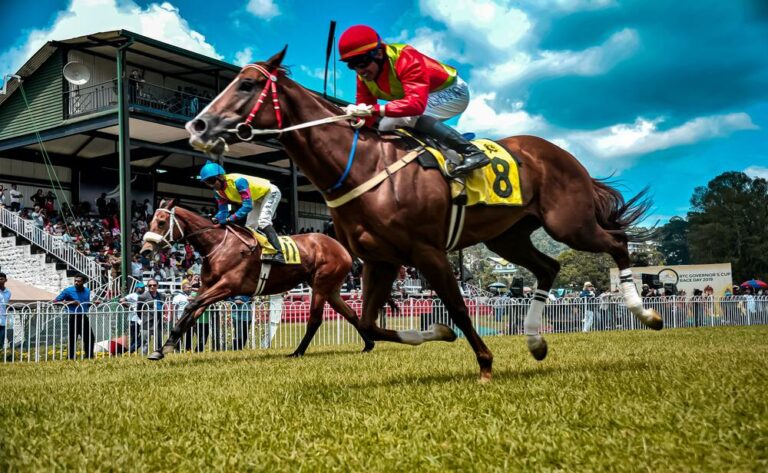Who Won the Triple Crown in Horses? Meet 13 Outstanding Champions


Triple Crown champions belong to an exclusive group. A horse must prevail in three contests over varying distances against the best opposition in the world over a demanding schedule. What, therefore, does it take to win the Triple Crown, and which horses have done it?
Sir Barton, Gallant Fox, Omaha, War Admiral, Whirlaway, Count Fleet, Assault, Citation, Secretariat, Seattle Slew, Affirmed, American Pharoah, and Justify are a few examples of Triple Crown champions. Since the race started more than 145 years ago, only these thirteen horses have won the Triple Crown.
The Triple Crown attracts attention from all over the world, and the horses who have won it are distinctive personalities with interesting backstories.
If you’re curious to see some artwork or other artefacts featuring racehorses, visit here.
Knowledge of the Triple Crown
The pinnacle of thoroughbred horse racing is the Triple Crown. Three events, the Kentucky Derby, Preakness Stakes, and Belmont Stakes, pit the top three-year-old racehorses in the world against one another.
A horse must win all three races to win the Triple Crown. Only thirteen horses have accomplished this accomplishment throughout the 150-year history.
Sir Barton was the first horse to complete the “Triple Crown” in 1919, even though the phrase “Triple Crown” had not yet been coined. Charles Hatton, a columnist for the Daily Racing Form, first used the expression in 1930.
Informative statistics
A gelding or a filly has never won the Triple Crown. The Triple Crown champions are all stallions.
Seven horses with chestnut coats and five with bay coats have won; War Admiral, with brown skin, is the lone exception. Two coat colours are predominant.
The oldest of the three Triple Crown competitions is the Belmont Stakes.
Triple Crown Champions
1. Sir Barton-1919
Male Stallion
The hue chestnut
Number 31: 13-6-5
It’s interesting to note that Sir Barton was entered for the Kentucky Derby in 1919, although his primary purpose was to pace stablemate Billy Kelly. In 1918, Billy Kelly won the two-year-old championship and was the early favourite to win the Kentucky Derby in 1919.
However, Sir Barton surprised the field by winning by five lengths since he didn’t realize he was supposed to be his stablemates’ rabbit. High Sir Barton approached the Preakness Stakes confidently, and four days later, he earned his second career victory. In both races, he led from start to finish.
Amazingly, Sir Barton competed in and won the Withers Stakes before dominating the Belmont Stakes, the third and final leg of the triple crown. Sir Barton set a new standard for a mile and three-eighths race in the Belmont Stakes. In just 32 days, he finished all of this.
2. Gallant Fox-1930
Male Stallion
The hue bay
17-game record: 11-3-2
As a result of Gallant Fox’s three victories, Charles Hatton of the Daily Racing Form is credited with coining the phrase “Triple Crown.
The racing world was captivated by the gallant Fox. As a two-year-old, he started tentatively but quickly gained the upper hand. The race schedules back then weren’t as set in stone as they are now.
Gallant Fox won the Preakness, the Kentucky Derby after just seven days, and the Belmont to complete the sweep. This was his first Triple Crown victory. Gallant Fox won the Triple Crown for 29 days.
3. Omaha-1935
Male Stallion
The hue chestnut
Number: 22-9-7-2
Omaha, the sole child of Triple Crown champion Gallant Fox, followed in his father’s Triple Crown-winning father’s footsteps and became only the third horse to win the Triple Crown.
Sunny Jim Fitzsimmons also taught Gallant Fox and served as his trainer. Omaha was a large chestnut colt who struggled throughout his career but prevailed when it mattered.
Two of his Triple Crown victories were on muddy tracks, and he often seemed to perform at his best in those conditions. It rained and was chilly during the Kentucky Derby, and the Belmont course was “sloppy.”
Omaha participated in the Withers Stakes alongside Sir Barton in the Triple Crown events, but unlike Sir Barton, he came in last.
4. War Admiral-1937
Male Stallion
The hue brown
Observation: 26: 21-3-1
One of the best racehorses to ever compete was named War Admiral. In addition to winning the Triple Crown, he also broke a track record at 1.5 miles and completed his three-year-old season without losing.
It’s interesting to note that his sire Man’ o War set the record seventeen years ago. Unfortunately, not many people recall War Admiral for his victories, but in one race, he lost.
In 1938, he competed against Seabiscuit. The contest featured the top two horses worldwide and was a significant event.
The race pitted War Admiral, a member of East Coast nobility, against Seabiscuit, the tiny, ugly duckling who had lost all seventeen of his races. Seabiscuit won the race and gained the nation’s heart, much to the disappointment of the War Admiral’s owner.
5. Whirlaway-1941
Male Stallion
The hue chestnut
Achieved in 60: 32-15-9
At the Kentucky Derby, Whirlaway put up a fantastic performance. Whirlaway was initially behind the leader by 14 lengths when the race got underway, but once he reached the finish line, he hit top speed and destroyed the opposition.
He established a new Kentucky Derby record with a time of 2:01 2/5 and tied the record for winning the race by the most significant margin, eight lengths. For twenty-one years, this record held.
Eddie Arcaro, a jockey with a hall of fame, rode him during his Triple Crown victories. His three and four years old seasons were his most remarkable. In forty-two starts, he never came in lower than third place, winning the Triple Crown.
6. Count Fleet-1943
Male Stallion
The hue bay
21st record: 16-4-1
Only two rivals entered the Belmont stakes to challenge Count Fleet, who was a powerful racehorse. He often destroyed his enemies in races in addition to winning them.
He won the Belmont Stakes by 25 lengths and broke the stakes record while setting the record for the quickest mile run by a two-year-old Thoroughbred. During his Triple Crown run, he also assisted Sir Barton in winning the Withers Stakes.
Unfortunately, Count Fleet’s ongoing ankle problem prevented him from fully recovering following his extraordinary Belmont effort. The Belmont Stakes marked the end of his outstanding racing career. After retiring, he was a prosperous stud that produced many exceptional racehorses, including Kentucky Derby champion Count Turf.
7. Assault-1946
Male Stallion
The hue chestnut
Record: 18-6-7 for 42
Assault was the only Texas-born horse to win the Triple Crown, reached two first, and was the first colt bred outside of Kentucky to win the Kentucky Derby.
Assault was bred on the King Ranch, widely regarded as the origin of the American Quarter Horse breed. When Assault was a foal, he had a terrible foot wound. There was a discussion of putting him down because the harm was so severe.
His breeding, however, spared his life, and he had a distinguished career. When urged to run, he didn’t favour his wounded leg but always kept a minor limp.
8. Citation-1948
Male Stallion
The hue bay
In the past: 45: 32-10-2
Citation started immediately, winning eight of the nine races he participated in as a two-year-old. During his three-year-old season, he captured the Triple Crown by winning sixteen straight races, including the Kentucky Derby, Precniss, and Belmont Stakes.
The Citation was the second Triple Crown mount for jockey Eddie Arcaro; the first was Whirlaway, who he rode in 1941 for the same farm, Calumet. Source had a record of 27 victories from 29 starts by the time he completed his third season.
The two and three-year-old seasons for Citation may have been the best in equine racing history.
9. Secretariat
Male Stallio
The hue chestnut
Achieved in 21: 16-3-1
After a 25-year absence, Secretariat captured the Triple Crown, breaking records along the way. He split last during his Kentucky Derby run but immediately gained distance.
Over the course, his pace picked up, and he ran each quarter-mile quicker than before. In a lightning-fast time of 1:59 2/5 seconds, he beat the previous Kentucky Derby record, which had never been broken.
In the Preakness, Secretariat took control early and defeated Sham, his closest challenger, by 2 1/2 lengths. Despite the broken clock, the official time was 1:53, and Secretariat set a new stakes record.
Secretariat put on a show at the Belmont, winning by 30 lengths in a time of 2:24—the quickest 1 12 miles on dirt in history—and setting a record for the Belmont Stakes.
Secretariat had remarkable confirmation and was a giant horse. “Big Red” is a fitting moniker for him. At any distance and on any terrain, he could prevail.
When he was two and three years old, Secretariat earned Horse of the Year. Like Muhammad Ali and Babe Ruth, he became a sports legend thanks to his accomplishments.
10. Seattle Slew-1977
Male Stallion
The hue dark bay
Record: 14-2-0 in 17
For a pitiful sum for a class horse, $17,500 was paid to buy Seattle Slew as a yearling. Seattle Slew won his first nine races, including the Belmont Stakes, Preakness, and Kentucky Derby. He became the first horse to accomplish this accomplishment by winning the Triple Crown while unbeaten.
In 2018, a horse named Justify, a progeny of Seattle Slew, became the next horse to achieve this accomplishment. In seventeen starts, Seattle Slew only finished one race outside the money.
Seattle Slew was turned out to stud after ceasing to race. He created outstanding racehorses that still impact today’s thoroughbred racing. The most prominent ones include Swale, who won the Kentucky Derby and Belmont Stakes, and A.P. Indy, who won the Belmont Stakes and was named Horse of the Year.
Tapit’s grandsire, Seattle Slew, was the top sire in North America in 2014, 2015, and 2016.
11. Affirmed-1978
Male Stallion
The hue chestnut
29th record: 22-5-1
Alydar was probably Affirmed’s most formidable opponent among all the Triple Crown winners. Each contest saw the two competing against one another and pushing each other to the limit, yet Affirmed managed to prevail.
Three of Affirmed’s five second-place results during her career were victories for Alydar. As the first equine to win two million dollars, Affirmed won the 1978 and 1979 Horse of the Year award. He only lost money once, and it was due to a disqualification.
He was notable since he was the triple crown champion War Admiral’s great-great-grandson. The origin of the term Affirmed is unknown. However, some speculate that it refers to the court of appeals’ decision to uphold the horse owners’ conviction for a crime.
12. American Pharoah-2015
Male Stallion
The hue bay
11-game record: 9-1-0
American Pharoah ended a 37-year drought of Triple Crown winners in 2015 when he won the Belmont Stakes. Some people started to think that it was difficult to win the Triple Crown in horse racing due to the competition.
Between Citation and Secretariat, for twenty-five years, the most significant drought on record occurred.
The 2015 Horse of the Year award went to American Pharoah, who won the two-year-old division. After a brief yet productive career, he was put to rest to stud. His first chances appear favourable.
It’s interesting to note that the same owners bought back both he and his sire at the same auction for almost the same amount. For $290,00, Zayat repurchased the sire of American Pharoah, Pioneer of the Nile. For $30,000, they repurchased American Pharoah in 2013.
13. Justify-2018
Male Stallion
The hue chestnut
6-0-0 record
In addition to winning the Triple Crown, Justify created history for the method he used. He is only the second undefeated horse to win the Triple Crown, following Seattle Slew, and the only horse to accomplish this accomplishment without competing as a two-year-old.
As the only Triple Crown winner to do so, he also had the fewest starts of any winner of the accomplishment, retiring after only six races. Horse of the Year for 2018 was chosen as Justify.





